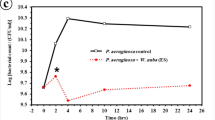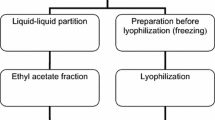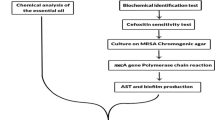Abstract
Maggot debridement therapy is an alternative method for treating of infected wounds in both human and veterinary medicine. Sterile larvae, such as from Lucilia cuprina (Diptera: Calliphoridae), stimulate wound healing through debridement of necrotic tissue and disinfection. Hence, we evaluated the antimicrobial activity from bacteria-pretreated L. cuprina maggot extracts against the most commonly isolated Gram-positive and Gram-negative bacteria from wounds. In short, whole-body extracts were collected after the sterile larvae were incubated for 24 h with a bacterial suspension of Staphylococcus aureus (Bacillales: Staphylococcaceae), Pseudomonas aeruginosa (Pseudomonadales: Pseudomonadaceae) or Methicillin-resistant S. aureus (MRSA). Larvae were cut into multiple pieces in a microtube containing sterile phosphate-buffered saline (PBS), centrifuged, and the supernatant was filtered and used to test antibacterial activities. A Colony-Forming Unit assay was performed at two incubation times (0 and 6 h) with pre-treated and non-treated (PBS) larval extracts groups, compared to a bacteria growth control group. The results showed effective activity against P. aeruginosa, a slight decrease in bacteria growth for S. aureus, and no significant differences for MRSA. With higher antibacterial activity for P. aeruginosa, L. cuprina may represent a powerful tool to the clinical approach of gram-negative wound healing.



Similar content being viewed by others
References
Abdel-Samad MRK (2019) Antiviral and virucidal activities of Lucilia Cuprina maggots’ excretion/secretion (Diptera: Calliphoridae): first work. Heliyon 5:e02791. https://doi.org/10.1016/j.heliyon.2019.e02791
Arora S, Sing LC, Baptista C (2010) Antibacterial activity of Lucilia Cuprina maggot extracts and its extraction techniques. Int J Integr Biology 9:43–48
Arora S, Baptista C, Sing LC (2011) Maggot metabolites and their combinatory effects with antibiotic on Staphylococcus aureus. Ann Clin Microbiol Antimicrob 10:1–8
Baer WS (1931) The treatment of chronic osteomyelitis with the maggot (larvae of the blowfly). J Bone Joint Surg 13:438–475
Barnes KM, Dixon RA, Gennard DE (2010) The antibacterial potency of the medicinal maggot, Lucilia Sericata (Meigen): variation in laboratory evaluation. J Microbiol Methods 82:234–237
Bexfield A, Nigam Y, Thomas S, Ratcliffe NA (2004) Detection and partial characterisation of two antibacterial factors from the excretions/secretions of the medicinal maggot Lucilia Sericata and their activity against methicilin-resistant Staphylococcus aureus (MRSA). Microbes Infect 6:1297–1304
Bexfield A, Bond AE, Roberts EC et al (2008) The antibacterial activity against MRSA strains and other bacteria of a < 500 Da fraction from maggot excretions/secretions of Lucilia Sericata (Diptera: Calliphoridae). Microbes Infect 10:325–333
Blake FAS, Abromeit N, Bubenheim M, LI L, Schmelzle R (2007) The biosurgical wound debridement: experimental investigation of efficiency and practicability. Wound Repair Regen 15(5):756–761
Cazander G, van Veen KEB, Bernards AT, Jukema GN (2009) Do maggots have an influence on bacterial growth? A study on the susceptibility of strains of six different bacterial species to maggots of Lucilia Sericata and their excretions/secretions. J Tissue Viability 18(3):80–87
Ceřovský V, Slaninova J, Fucik V, Monincova L, Bednarova L, Malon P, Stokrova J (2011) Lucifensin, a novel insect defensin of medicinal maggots: Synthesis and structural study. ChemBioChem 12:1352–1361 https://doi.org/10.1002/cbic.201100066
Daeschlein G, Mumcuoglu KY, Assadian O, Hoffmeister B, Kramer A (2006) In vitro antibacterial activity of Lucilia Sericata Maggot secretions. Skin pharmacology and physiology. 20(2):112–115
Echeverri MIW, Álvarez CR, Higuita SEH, Idárraga JCW, J.C.W. and, Franco MME (2010) Lucilia Eximia (Diptera: Callphoridae), uma nueva alternativa para La Terapia larval y reporte de casos en Colombia. Iatreia 23:107–116
El Shazely B, Veverka V, Fučík V, Voburka Z, Žďárek J, Čeřovský V (2013) Lucifensin II, a defensin of Medicinal maggots of the Blowfly Lucilia Cuprina (Diptera: Calliphoridae). J Med Entomol 50(3):571–578
Huberman L, Gollop N, Mumcuoglu KY, Breuer E, Bhusare SR, Shai Y, Galun R (2007) Antibacterial substances of low molecular weight isolated from the blowfly, Lucilia Sericata. Med Vet Entomol 21:127–131
Jaffar S, Ahmad S, Y. and, Lu Y (2022) Contribution of insect gut microbiota and their associated enzymes in insect physiology and biodegradation of pesticides. Front Microbiol 13:979383. https://doi.org/10.3389/fmicb.2022.979383
Jaklic D, Lapanje A, Zupancic K, Smrke D, Gunde-Cimerman N (2008) Selective antimicrobial activity of maggots against pathogenic bacteria. J Med Microbiol 57:617–625
Jiang KC, Sun XJ, Wang W, Liu L, et al (2012) Excretions/secretions from bacteria-pretreated maggot are more effective against Pseudomonas aeruginosa biofilms. PLoS One 7:e49815 https://doi.org/10.1371/journal.pone.0049815
Kawabata T, Mitsui H, Yokota K, Ishino K, Oguma K, Sano S 2010 induction of antibacterial activity in larvae of the blowfly Lucilia Sericata by an infected environment. Med Vet Entomol 24(4): 375–381
Kerridge A, Lappin-Scott H, Stevens JR (2005) Antibacterial properties of larval secretions of the blowfly, Lucilia Sericata. Med Vet Entomol 19:333–337
Lerch K, Linde HJ, Lehn N, Grifka J (2003) Bacteria ingestion by blowfly larvae: an in vitro study. Dermatology 207:362–366
Martini RK, Sherman RA (2003) Terapia De Desbridamento com larvas. J Bras Med 85:82–85
Mumcuoglu K, Ingber A, Gilead L, Stessman J, Friedmann R, Schulman H (1999) Maggot therapy for the treatment of intractable wounds. Int J Dermatology 38:623–627
Mumcuoglu KY, Miller J, Mumcuoglu M (2001) Destruction of bacteria in the digestive tract of the maggot of Lucilia sericata (Diptera: Calliphoridae). J Med Entomol 38: 161–166 https://doi.org/10.1603/0022-2585-38.2.161
Pare A The battell of quintin. (1557–1952) In: Keynes G (ed) The apologie and treatise of Ambroise Paré. The University of Chicago Press 68–70
Pöppel AK, Koch A, Kogel KH, Vogel H, Kollewe C, Wiesner J, Vilcinskas A (2014) Lucimycin, an antifungal peptide from the therapeutic maggot of the common green bottle fly Lucilia Sericata. Biol Chem 395(6):649–656. https://doi.org/10.1515/hsz-2013-0263
Sherman RA (2014) Mechanisms of maggot-induced wound healing: What do we know, and where do we go from here? Evid Based Complement Alternat Med 2014:592419
Sherman RA, Hall JR M., and, Thomas S (2000) Medicinal maggots: an ancient remedy for some contemporary afflictions. Annual Rev Entomol 81:45–55
Teh CH, Nazni WA, Lee HL, Fairuz A, Tan SB, Sofian-azirun M (2013) In vitro antibacterial activity and physicochemical properties of a crude methanol extract of the larvae of the blow fly Lucilia Cuprina. Med Vet Entomol 27(4):414–420
Thomas S, Andrews A, Hay P, Bourgoise S (1999) The antimicrobial activity of maggot secretions: results of a preliminary study. J Tissue Viab 9:127–132 https://doi.org/10.1016/S0965-206X(99)80032-1
van der Plas MJ, Jukema GN, Wai SW, et al (2008) Maggot excretions/secretions are differentially effective against biofilms of Staphylococcus aureus and Pseudomonas aeruginosa. J Antimicrob Chemother 61(1):117–22 https://doi.org/10.1093/jac/dkm407
Acknowledgements
The authors are grateful to the Laboratório de Bacteriologia (LABAC) and for the financial support of the Coordenação de Aperfeiçoamento de Pessoal de Nível Superior (CAPES).
Author information
Authors and Affiliations
Contributions
All authors contributed to the study conception and design. Material preparation, data collection and analysis were performed by JBD, TRRL, ARV, AFIMM. The first draft of the manuscript was written by JBD, and all authors critically revised all versions of the manuscript. Resources and supervision were provided by SGM and JFC.
Corresponding author
Ethics declarations
Conflict of interest
The authors declare that they have no conflict of interest.
Consent for publication
All authors consented for publication and approved the final manuscript.
Ethical approval
The protocols used in this study were reviewed and approved by the Ethic Committee on Animal Use of the Federal University of Santa Maria (CEUA/UFSM) (CEUA Nº: 5,414,110,220).
Additional information
Publisher’s Note
Springer Nature remains neutral with regard to jurisdictional claims in published maps and institutional affiliations.
Rights and permissions
Springer Nature or its licensor (e.g. a society or other partner) holds exclusive rights to this article under a publishing agreement with the author(s) or other rightsholder(s); author self-archiving of the accepted manuscript version of this article is solely governed by the terms of such publishing agreement and applicable law.
About this article
Cite this article
Dillmann, J.B., Lopes, T.R.R., de Vasconcelos, A.R. et al. In vitro antibacterial activity of whole body extracts from bacteria-pretreated Lucilia cuprina maggots. Int J Trop Insect Sci 44, 71–77 (2024). https://doi.org/10.1007/s42690-023-01136-x
Received:
Accepted:
Published:
Issue Date:
DOI: https://doi.org/10.1007/s42690-023-01136-x




